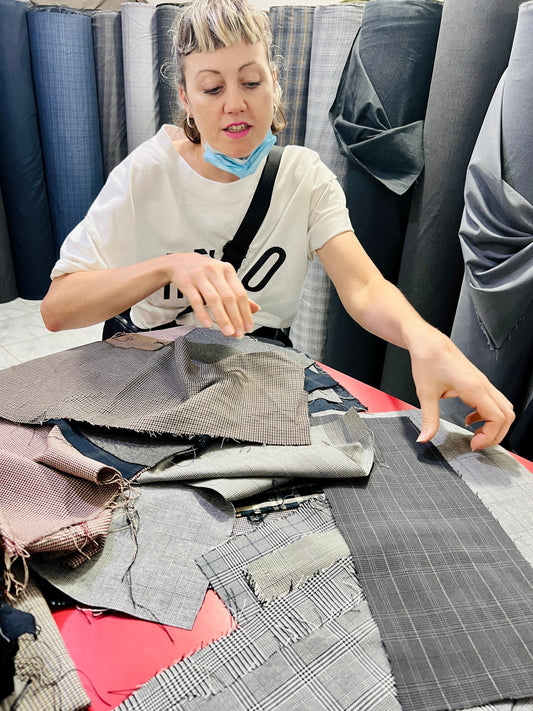
BEHIND THE SEAMS
WOMEN FIRST
Before we dive in, it’s important to say that the men on our team are incredible. This isn’t a reflection on them, but rather on the broader challenges within the garment industry. In the coming weeks, we’ll also be introducing the full team and highlighting the amazing work they do to make AL happen.

THE ELEPHANT IN THE ROOM
Where are the women?
One of the questions we’ve been asked is why, in so many of our videos from Heidi's trip to Bangladesh, is Heidi often surrounded by men? It’s a fair observation, and while it reflects some realities of the garment industry, it’s something we’ve been working to change from day one.
When we started working in Bangladesh, we made a clear and deliberate decision: to take a “women-first” approach to recruitment. Our local contacts, who helped set up our mini-factory, were intrigued but sceptical. “Why limit yourselves?” they asked. “Wouldn’t it be easier to find talent with a more open approach?”
They had a point. It’s not always easy to align our values with the realities of the industry or the culture we’re working within. We are, after all, guests in this country, and it’s crucial to approach these challenges with humility and respect.
But for us, this wasn’t about taking the easiest route. It was about starting somewhere—even if it meant small, meaningful steps toward progress.

FARZANA
Timing, talent and change
Farzana joined us at a pivotal moment. Her previous factory had closed, and we crossed paths at just the right time.
She brought with her a wealth of experience, quiet confidence, and leadership. For someone like Farzana, joining a small operation like ours was a leap of faith. Bigger factories often feel safer, more stable. But she believed in what we were trying to do and took the risk.
Farzana was instrumental in bringing our first collection to life—navigating suppliers, solving problems we didn’t even know existed, and keeping everything running smoothly. I still remember the day a fabric delay threatened to derail everything. Farzana, calm and composed, picked up the phone, adjusted timelines, and turned chaos into order.
When she moved on to an incredible new role, it was bittersweet. We were so proud of her, but it left a gap that wasn’t easy to fill. Recruiting experienced women for roles like head of production or technical lead has proven to be an ongoing challenge.
Why? Because in an industry where women often have to fight twice as hard to get to these positions, why risk moving to a smaller, less stable company? It’s not just about skills or ambition—it’s about opportunity, perception, and, often, survival.
It’s been humbling to realise that our values alone can’t change the structures that hold women back. And while Farzana taught us so much, she also showed us that change requires more than good intentions.

PROMA
From teacher to designer
Then there’s Proma.
Proma didn’t come from the garment industry—she was a teacher. But when we posted a design role, her application stood out.
Most of the applicants were men with years of experience, and we were repeatedly advised that hiring someone without that background would be a mistake. But Proma had something we couldn’t ignore: a creative spark and a passion for design.
Her determination was palpable, her English impeccable, and her ideas fresh. We decided to take a chance.
To make it work, we created a remote-working position for her—something almost unheard of in the industry. It gave her the space to grow at her own pace, away from the pressures of the factory floor.
Recently, Proma joined us in person to meet the team. Watching her confidently share her ideas and connect with her colleagues was one of those moments that makes all the challenges worth it.
But Proma’s story also highlights some of the challenges women face in entering creative roles. In Bangladesh, creativity isn’t always seen as a stable or respected career path. Families often encourage women to pursue professions like teaching or medicine—roles that are considered safer and more aspirational.
And then there’s recruitment bias. Out of 236 applicants for this role, only six were women. By the time we filtered for experience and availability, we were left with just two.
Proma’s journey reminds us that sometimes, the biggest barriers aren’t about skills—they’re about opportunity and belief.

FACING THE BARRIERS
Gender determines opportunity
Farzana and Proma have shaped who we are, but their stories also remind us how far we still have to go.
In an industry where gender often determines opportunity, we’ve realised that if we can’t find the experience, we have to build it. That’s why we’re working toward an AL Academy initiative—an effort to train women for managerial and technical roles and create a pipeline of talent for the future.
Be sure to check out part two, where we’ll introduce you to Champa—a woman breaking barriers in the technical side of garment making. Her story has changed the way we think about up-skilling, opportunity, and the power of technical skills in shaping the industry.
Chapters
-
![Women First [Part 1]](//www.aesthetic-laundry.co.uk/cdn/shop/articles/proma_c5ea29c1-d724-474a-8646-57e1e57c0faf.jpg?v=1737576816&width=533)
Women First [Part 1]
Where are the women? One of the questions we’ve been asked is why, in so many of our videos from Heidi's trip to Bangladesh, is Heidi often surrounded by men?...
Women First [Part 1]
Where are the women? One of the questions we’ve been asked is why, in so many of our videos from Heidi's trip to Bangladesh, is Heidi often surrounded by men?...
-

Our Deadstock Fabric Story
As part of Heidi's trip to Bangladesh she got to witness first hand what it means to source and utilise deadstock fabric (and why we differ from the high street....ie...
Our Deadstock Fabric Story
As part of Heidi's trip to Bangladesh she got to witness first hand what it means to source and utilise deadstock fabric (and why we differ from the high street....ie...

![Women First [Part 1]](http://www.aesthetic-laundry.co.uk/cdn/shop/articles/proma_c5ea29c1-d724-474a-8646-57e1e57c0faf.jpg?v=1737576816&width=533)
